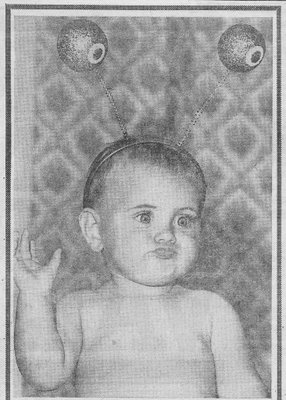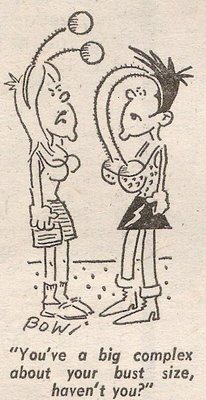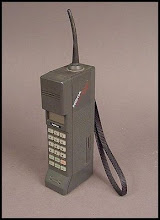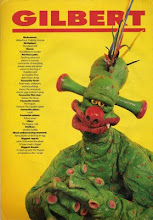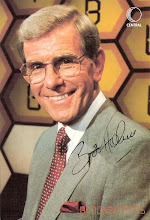 1980s signed cast cards of Arthur Pentelow (Henry Wilks) and Ronald Magill (Amos Brearly). Here's a fascinating fact: did you know that until the early 1980s UK soap cast cards provided by TV studios were always in black and white?
1980s signed cast cards of Arthur Pentelow (Henry Wilks) and Ronald Magill (Amos Brearly). Here's a fascinating fact: did you know that until the early 1980s UK soap cast cards provided by TV studios were always in black and white?Ah, those were the days... Arthur Pentelow as Henry Wilks (or should that be Mr Wilks?!) and Ronald Magill as Amos Brearly. These two ran The Woolpack Inn and shared the living accommodation from 1973 to 1991. A now legendary soap pairing.
Actually there were a pair of Woolpacks, too. The original building was declared unsafe due to subsidence in 1976, so Amos and Mr Wilks relocated to premises elsewhere in the village.
Mr Wilks was a warm hearted retired businessman. Amos was... well... erm... it's not easy to summarise Amos. He was childish. Pompous. Usually rigidly formal. Given to rapid fads and enthusiasms. He was also naive and very good hearted. Underneath it all.
The character of Amos evolved. When he became Beckindale correspondent on the Hotten Courier in 1976, he puffed himself up like a peacock. But it took until the early 1980s before the character was refined and honed to perfection. Watch any 1970s episode of Emmerdale Farm, and I think you might agree that Amos was quieter, more restrained and dour than in the 1980s - when he was gloriously potty, pursuing fad after fad in quick succession, bridling at Mr Wilks' attempts to bring him down to earth and generally being a wonderful nuisance.
1980 was an absolutely pivotal year for the Amos character - with Seth Armstrong leaving The Malt Shovel bar to become a regular at The Woolpack, and Al Dixon joining the cast as Walter, Amos became more animated, fad-ridden and bizarre than ever before!
The '80s were a truly splendid era during which Amos and Mr Wilks story lines abounded, as the show became an all-year-round soap.
Do you remember the time when Amos got into transcendental meditation? The time he went "upwardly mobile" and took up golf with Alan Turner? The time he turned to bee keeping? The time he baked a cake? The time he was cursed by a gypsy? The time...
If all these sound like Amos-only story lines, rest assured that Mr Wilks was always there, advising, trying to moderate his friend's behaviour, and generally suffering!
Fortunately, Mr Wilks had friends elsewhere or he would, no doubt, have gone insane!
 Amos and Mr Wilks have a disagreement in 1980...
Amos and Mr Wilks have a disagreement in 1980... ... and they're still at in 1989. Dolly Skilbeck (Jean Rogers) looks on.
... and they're still at in 1989. Dolly Skilbeck (Jean Rogers) looks on. A pain in the neck to Amos was one of his best 1980s customers and arch enemy, Seth Armstrong (Stan Richards). How he loved to wind the big key in Amos' back! In 1980, Amos commented disapprovingly on Seth's loyalty to the Malt Shovel. Seth was just becoming established as a regular character back then, having first appeared in a few episodes in 1978. From 1980 onwards, Seth switched to The Woolpack, and absolutely loved to get under Amos' skin! Remember the time he booked two strippers (and a python!) to perform at The Woolpack - much to Amos' horror? Amos ordered them out and the pub was wrecked by irate customers!
A pain in the neck to Amos was one of his best 1980s customers and arch enemy, Seth Armstrong (Stan Richards). How he loved to wind the big key in Amos' back! In 1980, Amos commented disapprovingly on Seth's loyalty to the Malt Shovel. Seth was just becoming established as a regular character back then, having first appeared in a few episodes in 1978. From 1980 onwards, Seth switched to The Woolpack, and absolutely loved to get under Amos' skin! Remember the time he booked two strippers (and a python!) to perform at The Woolpack - much to Amos' horror? Amos ordered them out and the pub was wrecked by irate customers!I've recently viewed hundreds of 1980s Emmerdale Farm episodes, and watching Amos reach the peak of his peculiarity, aided by Seth Armstrong and Walter and the long-suffering Mr Wilks, has been a great pleasure.












